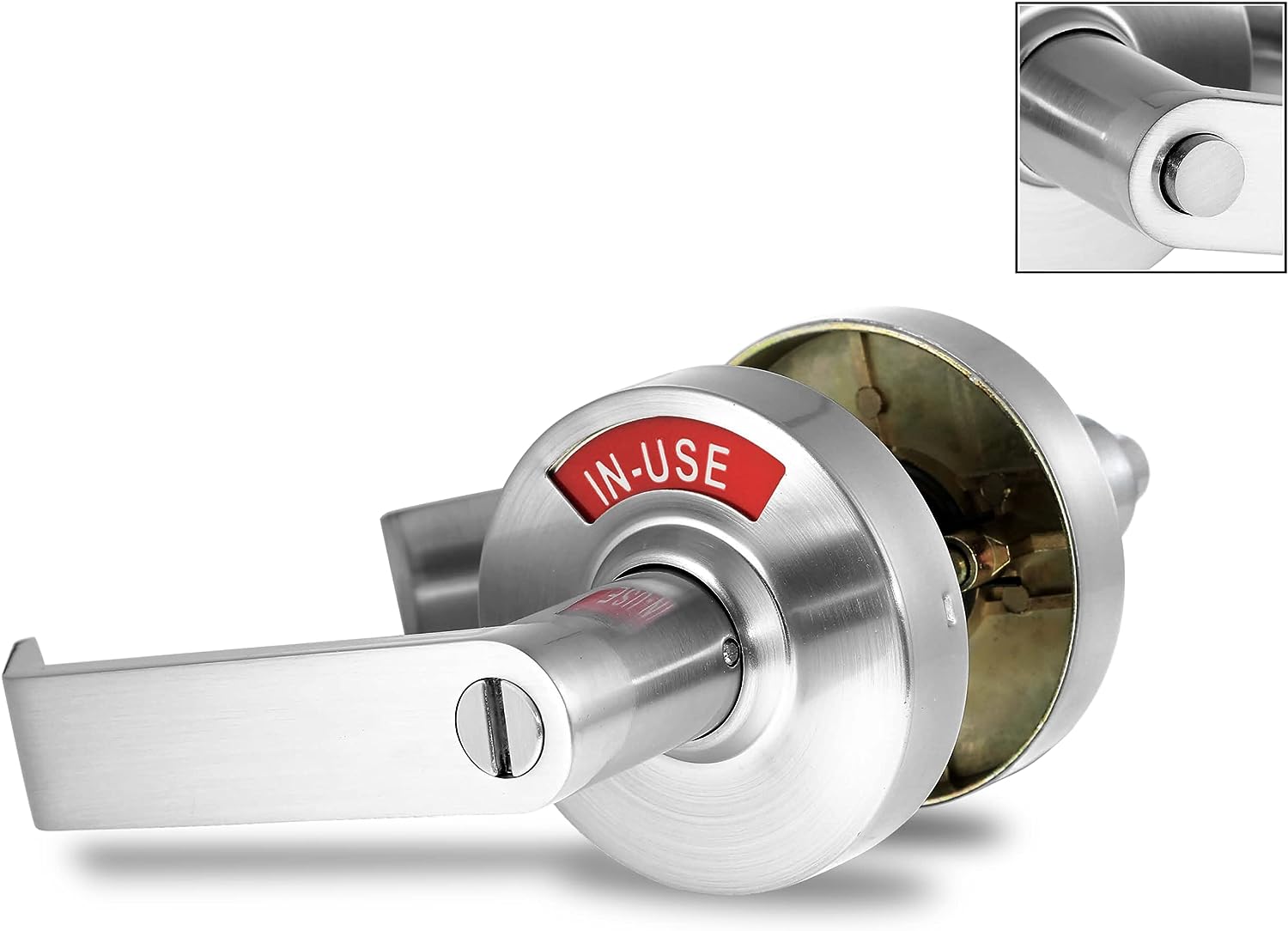In an era that emphasizes inclusivity and accessibility, ensuring that public spaces cater to all individuals, regardless of their physical abilities, is paramount. The Americans with Disabilities Act (ADA) has set forth standards to ensure public spaces are accessible to everyone, including those with disabilities. One key aspect of this accessibility revolves around door locks. Door locks might seem like a minor detail, but when you consider the daily challenges faced by individuals with disabilities, the importance of ADA-compliant locks becomes clear. This article delves into the intricacies of ADA door locks, shedding light on their design, requirements, benefits, and much more.
What are ADA-compliant locks?
ADA-compliant locks are designed in adherence to the guidelines set by the Americans with Disabilities Act (ADA). These guidelines ensure that individuals with disabilities, including those with limited hand dexterity, strength, or those using assistive devices, can easily operate door locks without facing any undue strain or difficulty.
At the core of ADA-compliant locks is the principle of universal design, which emphasizes creating products and environments that are usable by all people, to the greatest extent possible, without the need for adaptation. In the context of door locks, this means creating mechanisms that don't require tight grasping, pinching, or twisting of the wrist to operate.
It's essential to note that ADA-compliance goes beyond just the functional aspect of the lock. It encompasses a holistic approach that considers the lock's design, height placement, operational force, and other factors to ensure maximum accessibility and ease of use. The main goal is to create an inclusive environment where door locks, a fundamental aspect of privacy and security, are not a barrier but a facilitator for individuals of all abilities.
What makes door hardware ADA compliant?
Door hardware plays a pivotal role in ensuring seamless access to spaces, and when it comes to ADA compliance, every detail matters. From door handles to push plates, ADA-compliant door hardware is designed to be user-friendly, particularly for individuals with disabilities.
Here's what sets ADA-compliant door hardware apart:
- Operational Mechanism: ADA standards dictate that door hardware should be operable with one hand and should not require tight grasping, pinching, or twisting of the wrist. Lever handles, push-type mechanisms, and U-shaped handles are typical examples of ADA-compliant hardware.
- Operational Force: Similar to deadbolts, door hardware should not demand more than 5 lbs of force for operation. This ensures that individuals with limited hand strength can easily use the hardware.
- Height and Position: The positioning of door hardware is crucial. ADA guidelines recommend that hardware be installed between 34 inches and 48 inches above the floor, making it accessible for everyone, including those in wheelchairs.
- Clearance: Door hardware should provide enough clearance for hands, especially for closed-fist operation. This is particularly important for handles and pulls, ensuring that individuals don't hurt their knuckles or face difficulty while using them.
- Smooth Edges: ADA-compliant door hardware is designed with user safety in mind. This means no sharp or abrasive surfaces. Every edge and surface should be smooth to touch, preventing any potential injuries.
- Visual and Tactile Indicators: Some ADA-compliant door hardware incorporates visual or tactile indicators. For instance, emergency exit hardware might have a distinct texture or visual cue to guide individuals with visual impairments.
- Materials and Finish: While ADA does not mandate specific materials, it's recommended to use non-reactive and hypoallergenic materials. The finish should also be non-glare, which can be beneficial for individuals with certain visual impairments.
In conclusion, ADA-compliant door hardware is a testament to thoughtful design that prioritizes accessibility without compromising on aesthetics or functionality. Every component is crafted keeping in mind the diverse needs of users, ensuring that doors are not barriers but welcoming gateways for all.
ADA Bathroom Door Lock Requirements
Bathrooms are essential facilities, and ensuring they are accessible to everyone, including individuals with disabilities, is of utmost importance. The ADA has set specific requirements for bathroom door locks to ensure ease of use and accessibility.
Here's a breakdown of these requirements:
- Operational Mechanism: Much like other ADA-compliant hardware, bathroom door locks should be operable using a single hand, without the need for tight grasping, pinching, or twisting of the wrist. Lever handles, push buttons, or other accessible mechanisms are preferred over traditional round knobs.
- Height Placement: According to ADA guidelines, the optimal height for bathroom door lock mechanisms falls between 34 inches and 48 inches from the floor. This ensures that the lock is within reach for most individuals, including those using wheelchairs.
- Operational Force: The force required to engage or disengage the lock should not exceed 5 lbs. This ensures that even individuals with limited hand strength can easily operate the lock.
- Clearance: There should be ample clearance around the handle or lock mechanism, ensuring that individuals can comfortably grip and operate it without any hindrance.
- Emergency Access: Especially in public restrooms, ADA-compliant bathroom locks should offer a means of emergency access from the outside. This could be a small slot or hole that allows the lock to be disengaged using a specialized tool in case of emergencies.
- Indicator Features: Many ADA-compliant bathroom locks come equipped with occupancy indicators. These indicators turn red or display "In-Use" when the stall or room is in use and turn green or display "Vacant" when it's free. This feature enhances privacy and reduces wear and tear on the lock as users don't have to check the door's status physically.
- Smooth Edges and Surfaces: All components of the lock, including handles, levers, or buttons, should have smooth edges and surfaces to prevent accidental injuries.
- Consistent Operation: The lock operation, whether locking or unlocking, should be consistent and intuitive across facilities. This ensures that users familiar with the operation in one restroom will find it easy to operate locks in other restrooms as well.
In essence, ADA bathroom door lock requirements are designed to offer the highest levels of accessibility, safety, and user-friendliness. These standards not only ensure compliance with the law but also reflect an establishment's commitment to serving all its patrons equitably.
Benefits of ADA Door Locks
The adoption of ADA-compliant door locks goes beyond merely adhering to legal mandates. These specialized locks offer a plethora of benefits that elevate the user experience, enhance safety, and reflect positively on the establishment or facility.
Here's an in-depth look at the manifold advantages of ADA door locks:
- Promoting Inclusivity: ADA door locks champion the ethos of an inclusive society where every individual, irrespective of their physical abilities, can access and utilize facilities without hindrance. It underscores the establishment's commitment to serve all patrons equitably.
- Enhanced User Experience: Designed for ease of use, ADA door locks often prove to be more user-friendly even for individuals without disabilities. Their intuitive design and smooth operation cater to all users, ensuring a seamless experience.
- Avoiding Legal Repercussions: Adhering to ADA guidelines is not just morally right but also a legal requirement in many jurisdictions. Employing ADA-compliant locks can save businesses from potential lawsuits, penalties, and damage to their reputation.
- Boosting Business Reputation: For businesses, having ADA-compliant locks signals a commitment to customer care and inclusivity. It can positively impact the brand's image, making it more appealing to a broader customer base.
- Safety and Emergency Features: Many ADA locks have built-in safety mechanisms, allowing for external emergency access. This dual feature ensures privacy when needed, but accessibility during critical situations.
- Longevity and Durability: Given their design that minimizes wear and tear (thanks to occupancy indicators and smooth operation), ADA locks often enjoy a longer lifespan, proving to be cost-effective in the long run.
- Versatility in Design: Contrary to some misconceptions, ADA compliance doesn't limit aesthetic choices. Modern ADA door locks come in a plethora of designs, materials, and finishes, ensuring that functionality and style go hand in hand. For example, Vizilok ADA locks are available in satin chrome, satin brass, oil-rubbed bronzed and PVD brass finishes.
In essence, ADA door locks are not just about adhering to guidelines but about embracing a philosophy of inclusivity, safety, and user-centric design. The myriad benefits they offer make them an indispensable choice for modern establishments and homes alike.
ADA Door Lock vs Non-ADA Door Lock
To provide a clear distinction between ADA-compliant door locks and non-ADA door locks, let's break down their characteristics in a tabular format:
| Features | ADA Door Lock | Non-ADA Door Lock |
|---|---|---|
| Operational Mechanism | One-handed operation without tight grasping, pinching, or wrist twisting. | May require two hands, pinching, or wrist twisting. |
| Operational Force | No more than 5 lbs of force required. | Force varies; some models may require significant force. |
| Height Placement | Typically between 34 inches and 48 inches from the floor. | Placement can vary and might not be easily accessible for all individuals. |
| Clearance | Ample clearance around the handle for comfortable operation. | Clearance may be limited, potentially causing discomfort during operation. |
| Emergency Access | Often comes with a means of emergency access from the outside. | May or may not have emergency access features. |
| Indicator Features | Typically features occupancy indicators (e.g., red for occupied, green for vacant). | Rarely features occupancy indicators. |
| Smooth Edges and Surfaces | All components are smooth to prevent injuries. | May have components with sharp or abrasive edges. |
| Consistency in Operation | Intuitive and consistent operation across facilities. | Operation can vary widely between models and brands. |
| Design Flexibility | Prioritizes accessibility but comes in various designs and finishes. | Wider range of designs, but might not prioritize accessibility. |
Common Misconceptions About ADA Door Locks
With the increasing emphasis on accessibility and inclusivity, ADA-compliant door locks are more prevalent than ever. However, with their rise in popularity come a few misconceptions that can cloud judgment and lead to confusion.
Let's debunk some of these common myths:
-
Only for Public Buildings
One of the most widespread misconceptions is that ADA locks are solely for commercial or public spaces. While ADA standards primarily target public areas, the principles of accessibility and inclusivity are universal. Many homeowners are now opting for residential ADA-compliant locks to cater to family members with disabilities or simply for their ease of use. -
Compromised Security
Some believe that because ADA-compliant locks are designed for ease of use, they might be less secure. In reality, ADA locks meet the same security standards as non-ADA locks. Their design prioritizes accessibility without compromising on security. -
Aesthetic Limitations
There's a notion that ADA-compliant locks are not as aesthetically pleasing due to their functional design. However, modern ADA door locks come in a variety of styles, finishes, and designs, ensuring that establishments don't have to sacrifice style for functionality. -
Higher Maintenance
Another myth is that ADA locks require more frequent maintenance. These locks are designed for durability and longevity, much like their non-ADA counterparts. Features like occupancy indicators can reduce wear and tear, extending the lock's lifespan. -
Costly Affair
While some ADA locks might have a slightly higher initial cost due to their specialized design, the long-term benefits – from potential legal savings to reduced replacement costs due to durability – often outweigh the initial investment. -
Only for Wheelchair Users
ADA compliance is not just about wheelchair accessibility. It's about ensuring ease of use for all, including those with limited hand strength, dexterity issues, or other disabilities. ADA-compliant locks are designed with a broad spectrum of users in mind.
Understanding the realities behind these misconceptions can empower individuals and businesses to make informed decisions. ADA door locks represent a step towards a more inclusive world, and recognizing their true value is key to fostering accessibility for all.
Where to Install ADA Locks?
Ensuring accessibility through ADA-compliant locks isn't limited to specific areas or rooms. Instead, it's about fostering inclusivity across various spaces.
Here's a comprehensive guide on where ADA locks should ideally be installed:
- Public Restrooms: One of the most common areas where ADA locks are crucial. Both stall doors and the main restroom doors should be equipped with ADA-compliant locks to ensure privacy and accessibility for all.
- Entry and Exit Doors: Whether it's a business establishment, public facility, or residential complex, main entry and exit doors should be ADA-compliant, ensuring that everyone, including individuals with disabilities, can access the premises with ease.
- Private Offices and Meeting Rooms: In corporate settings, private offices and meeting rooms often require locks for confidentiality. Installing ADA-compliant locks ensures that all employees can access and secure these spaces irrespective of their physical abilities.
- Educational Institutions: Classrooms, labs, faculty rooms, and other spaces within schools and colleges should be equipped with ADA locks to ensure an inclusive learning environment.
- Healthcare Facilities: Hospitals, clinics, and other healthcare establishments should prioritize ADA-compliant locks, especially in patient rooms, restrooms, and private consultation areas.
- Hotels and Hospitality: Guest rooms, conference halls, restrooms, and other facilities within hotels should be ADA-compliant, ensuring a comfortable stay for all guests.
- Recreational Facilities: Spaces like theaters, sports arenas, clubhouses, and other recreational venues should incorporate ADA locks in restrooms, private booths, changing rooms, and other areas that require secured access.
- Transportation Hubs: Airports, bus stations, and train stations witness a diverse group of individuals daily. Ensuring ADA-compliant locks in restrooms, lounges, and other private spaces is essential for accommodating travelers with disabilities.
- Residential Complexes: While primarily a requirement for public spaces, many modern residential complexes are adopting ADA locks for common areas to cater to residents with disabilities and to promote inclusivity.
- Government Buildings: As spaces that should set the benchmark for inclusivity, all government offices, courthouses, and public service buildings should be equipped with ADA-compliant locks.
Conclusion
The journey towards creating an inclusive and accessible environment is a collective one, with every detail playing a pivotal role. While seemingly a minor facet of this journey, ADA-compliant door locks bear significant importance in ensuring that spaces are welcoming and accommodating for everyone. As we've delved into the nuances of these specialized locks, it's evident that their adoption goes beyond legal mandates—it's about embracing a philosophy of inclusivity, understanding, and empathy.
By prioritizing ADA-compliant locks, establishments not only uphold the rights and dignity of individuals with disabilities but also enhance the overall user experience for everyone. In a world striving for equality and accessibility, understanding and implementing ADA door lock standards is a step in the right direction—a step towards a more inclusive tomorrow.
Vizilok is a well-known brand of ADA-compliant commercial restroom locks. Our door locks are installed in thousands of restroom facilities all over the US. Check out the bestsellers collection to find out more about our products, or contact us for more information or custom quotes.



